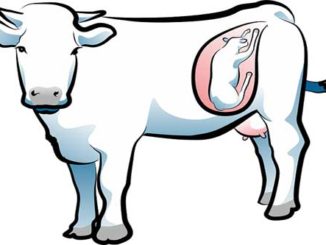1. Barium chloride test
- This test is used for pregnancy diagnosis in cows and buffaloes.
- It gives more than 90% reliable results.
Principle
End-products of progesterone (after metabolisation in liver) present in the urine and this prevents precipitation of barium chloride while oestrogens favour precipitation.
Procedure
- Take 5 ml of urine in a test tube.
- Add 5-6 drops of 1 % barium chloride solution and mix well.
Interpretation
- No precipitation- Pregnant
- Clear white precipitation- Non-pregnant
Advantage
Pregnancy can be diagnosed even at 3 to 4 weeks of gestation.
Limitation
- When oestrogens in urine are of plant origin, it may give False result.
- Presence of persistent corpus luteum and corpus luteum of pregnancy up to some days after parturition give false positive result.
2. Sodium hydroxide test
- This test is also used for pregnancy diagnosis in cows and buffaloes.
- This test has a reliability of 80-90%.
Procedure
- Take 0.25 m!. of cervical mucus in a test tube.
- Add to it 5 ml of 10% s NaOH solution
- Heat it till boiling.
Interpretation
- Orange- Pregnant
- Pale colour- Non-pregnant
3. Specific gravity method
This test has more than 90% reliability both in cows and buffaloes.
Principle
Specific gravity of cervical mucus is increased with progesterone while it is decreased with oestrogens.
Procedure
- Take few ml. of copper sulphate solution having specific gravity 1.008 in a test tube.
- Add 0.25 ml cervical mucus in the copper sulphate solution.
Interpretation
- If mucus sinks- Pregnant
- If mucus floats- Non-pregnant
4. Seed bio- assay method (Punyakoti test)
- This method is used for pregnancy diagnosis both in cows and buffaloes.
Principle
Germination of wheat! barley / moong is prevented by four-fold rise in concentration of abscicic acid in the pregnant animals. It induces dormancy in seeds.
Procedure
- The urine is collected and diluted four times with distilled water.
- Two petri-dishes are taken and filter papers are placed in it.
- About 15-20 wheat / barley / moong seeds are kept in each petri-dish.
- About 10-15 ml. of the above diluted urine sample is added to one petri-dish, while in other petridish only water is added (control).
- Cover the petri-dishes to prevent evaporation and keep for 5 days.
Interpretation
- No germination and turn black or if germinate but shoots are less than 1cm. in length – Pregnant.
- 35-60% germination with moderate shoot length (4 cm.) – Nonpregnant.
- Control petri-dish – 60-80% germination and shoot length about 6 cm.
5. Cuboni Test
- This test is used for pregnancy diagnosis in mare.
- It involves detection of oestrogen in the urine of mare and can be performed after 150 days of conception
Principle
The urine is hydrolysed with HCl, and benzene is added for extraction of oestrogen from hydrolysed urine.
Procedure
- Take 15 ml urine in a test tube and add to it 3 ml conc. HCl.
- Heat the mixture in a water bath at boiling point for 10 minutes.
- Cool the mixture.
- Pour the mixture into a separating funnel and add to it 18 ml benzol and shake well.
- Collect the benzol layer in an other test tube and add to it 10 ml. cone. H2S04•
- Heat the mixture at 80ºC for 5 minutes and cool.
Interpretation
- Green fluorescence- pregnant
- No colour- Non-pregnant







Be the first to comment